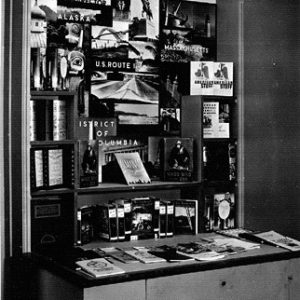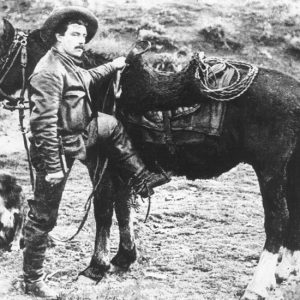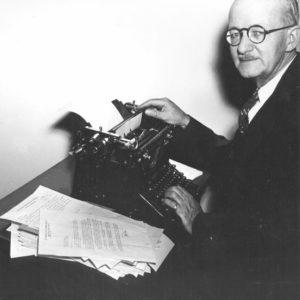calsfoundation@cals.org
Arkansas Writers Project
The Federal Writers’ Project (FWP) served as a cultural anchor for Arkansas during the years of the Great Depression by providing work for unemployed and underemployed writers, who observed, recorded, and described the contemporary cultural conditions in their work. These texts serve to this day as the most complete and comprehensive documentation of Arkansas history and culture available from the viewpoint of Arkansans.
The FWP was initiated in July 1935 as a component of President Franklin D. Roosevelt’s Works Progress Administration (WPA) program. The intention of the FWP was to provide employment to out-of-work writers affected by the Depression. The FWP writers were engaged in writing local histories, travelers’ guides, and cultural chronicles, particularly those relating to long-oppressed American groups such as Native Americans and African Americans. During its lifespan, more than 7,000 writers were employed nationally by the FWP. Similar projects were initiated by the WPA for other aspects of the arts, such as painting and theater.
While the FWP was administered centrally in Washington DC, a local office was created within each state. Bernie Babcock served as state director of the Arkansas Writers’ Project, and Charles J. Finger served as state editor until his death in 1941.
The primary production of the Federal Writers’ Project was the American Guide Series, which encompassed a narrative guide for each state then in the Union, as well as for many major cities, regions, and territories. The series constituted a comprehensive survey of American places and culture, described in a literary fashion and laid out in a manner accessible both to the reader as literature and to the traveler as tour guide. Members of the editorial staff for the Guide included Jean Winkler, Walter Rowland, Faye Webber, and Richard McCue. Each state maintained an autonomous writing staff, often populated with authors of great talent. The list of American Guide Series contributors who went on to distinguished careers in writing includes Richard Wright, Ralph Ellison, Loren Eiseley, Saul Bellow, Studs Terkel, and Zora Neale Hurston. Charles J. Finger, a British-born adventurer and recognized author, served in an editorial role for the Arkansas guide.
Between 1937 and 1942, the FWP’s American Guide Series produced nearly 300 volumes, including one for the state of Arkansas. First published in 1941, Arkansas: A Guide to the State was similar to other guides in the series in that it presented an orderly, sober description of the state’s attributes, from days of ancient culture through contemporary times. The guide included focused descriptions of several major urbanized areas in the state and provided explicit turn-by-turn driving instructions to facilitate motor touring, at that time still a relatively novel form of travel. While ample attention was given to the sort of portrayals outsiders might have held about Arkansas, the writers were also careful to include aspects that would depict the state in a more progressive light, as in the section focused upon industry, which featured descriptions of railroads, lumbering, the petroleum industry, and especially the state’s labor struggles. The guide’s introduction credited the editorial assistance of W. J. Lemke, a leading journalist in Arkansas at the time.
Another project of the FWP was the recording of slave narratives, which began in 1936. Assembled as an account of slavery in the United States, they were presented as a series of quasi-interviews, dependent wholly upon the memories of the former slaves. Led at the federal level by esteemed American folklorist John Lomax, the slave narratives presented a vivid first-hand history of slavery. The slave narratives were usually transcribed in phonetic dialect and with colloquial pronunciations intact, as instructed by the staff of the FWP. In Arkansas, state FWP director Babcock employed at least three full-time workers in the field, including African Americans Samuel Shinkle Taylor and Pernella Anderson.
The FWP was known to have employed writers with left-wing sympathies and was thus regularly accused of serving as a hotbed for anti-American activities. In 1938, a committee of the U.S. Congress was formed to investigate the FWP for its associations with communism in an effort to discredit not only the FWP but also the entirety of Roosevelt’s New Deal and its programs. In September 1939, amid concerns both political and fiscal, Congress voted to transfer control of the FWP to the individual states. With the subsequent transfer of control, the state FWP offices were required to become significantly self-supporting. Renamed the Writers’ Program, the reorganized effort was to be administered by the newly created Federal Works Administration. With the attack on Pearl Harbor and the entry of the United States into World War II, the FWP declined in importance and finally ended with the conclusion of the entire WPA in June 1943.
For additional information:
Bold, Christine. The WPA Guides: Mapping America. Jackson: University Press of Mississippi, 1999.
Lankford, George E., ed. Bearing Witness: Memories of Arkansas Slavery: Narratives from the 1930s WPA Collections. 2nd ed. Fayetteville: University of Arkansas Press, 2006.
Mangione, Jerre. The Dream and the Deal: The Federal Writers’ Project, 1935–1943. Boston: Little, Brown, 1972.
Rowe, Earl David. “The Federal Writers’ Project in Arkansas, 1935–1942.” MA thesis, University of Arkansas, 1990.
“Writers’ Program of the Work Projects Administration in the State of Arkansas,” in Arkansas: A Guide to the State. New York: Hastings House, 1941.
Gregory Herman
University of Arkansas School of Architecture
 Arkansas Freedom of Information Act
Arkansas Freedom of Information Act Early Twentieth Century, 1901 through 1940
Early Twentieth Century, 1901 through 1940 Bernie Babcock
Bernie Babcock  Federal Writers' Project Booth
Federal Writers' Project Booth  Charles Finger
Charles Finger  Walter Lemke
Walter Lemke  John Lomax
John Lomax 




Comments
No comments on this entry yet.